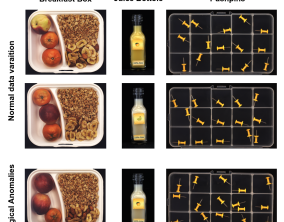Anomaly detection using set representations and density estimations

Anomaly detection aims to automatically identify samples that exhibit unexpected behavior. We tackle the challenging task of detecting anomalies consisting of an unusual combination of normal elements (`logical anomalies`). For example, consider the case where normal images contain two screws and two nuts but anomalous images may contain one screw and three nuts. We propose to detect logical anomalies using set representations. We score anomalies using density estimation on the set of representations of local elements. Our simple-to-implement approach outperforms the state-of-the-art in image-level logical anomaly detection and sequence-level time series anomaly detection.(nuts or screws) occur in natural images, previous anomaly detection methods relying on anomalous patches would not succeed. Instead, a more holistic understanding of the image is required. You can check out the preprint at: https://arxiv.org/pdf/2302.12245.pdf
Goal
Set Features for Fine-grained Anomaly Detection
Researchers
What we did
Fine-grained anomaly detection has recently been dominated by segmentationbased approaches. These approaches first classify each element of the sample (e.g., image patch) as normal or anomalous and then classify the entire sample as anomalous if it contains anomalous elements. However, such approaches do not extend to scenarios where the anomalies are expressed by an unusual combination of normal elements. We overcome this limitation by proposing set features that model each sample by the distribution of its elements. We compute the anomaly score of each sample using a simple density estimation method. Our simple-to-implement approach1 outperforms the state-of-the-art in image level logical anomaly detection (+3.4%) and sequence-level time series anomaly detection (+2.4%).
Results
Preprint: https://arxiv.org/pdf/2302.12245.pdf
Application of Multimodal Time Series for Field Crops Phenotyping by Fusing UAV Borne Hyperspectral Imagery and 3D Canopy Models
Modern agriculture and food production systems are facing increasing pressures from climate change, land and water availability, and, more recently, a pandemic. Despite incredible advances in genetic tools over the past few decades, our ability to accurately assess crop status in the field, at scale, has been severely lacking until recently. Thanks to recent advances in airborne Artificial Intelligence and Remote Sensing, we are now looking to quantify field phenotypic information accurately and integrate the big data into useful information to the breeder. Machine Learning algorithms will be developed and used to train and test models based on hyperspectral imagery and 3D crop canopy data to estimate field crops traits that are relevant for breeders to select the most suitable genotypes to increase crop production.
Goal
The pipeline to be developed includes: (i) preprocessing: image registration, denoising and segmentation; (ii) training: learning the visual signature of plant traits; and (iii) validation: validation of the trained models.
Researchers
What we did
In progress
Results
Forthcoming



